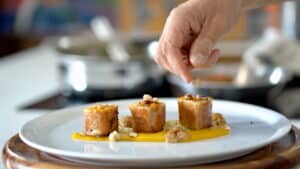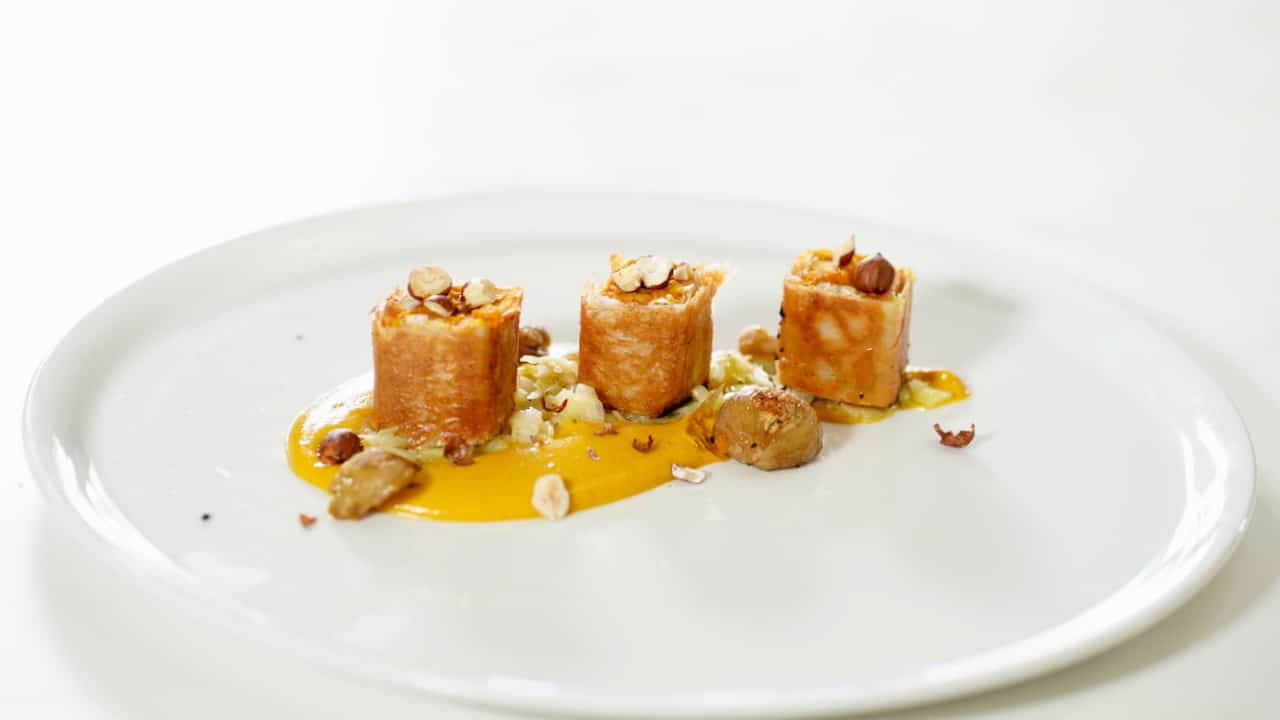Ingredients
Equipment
Method
Red Kuri Squash vs Potimarron
- Red kuri squash is a thin skinned orange colored winter squash, a cultivated variety of the species Cucurbita maxima. It looks like a small pumpkin without the ridges. It belongs to the Hubbard squash group. Inside the outer edible skin there is a firm flesh that provides a very delicate and mellow chestnut-like flavor. Other kinds can be used instead like honeynut and Kabocha squashes.

Cheeses Options
- * I chose to blend my roasted pumpkin filling with fresh goat cheese, but many other mild cheeses may be used such as cream cheese, mascarpone, and ricotta.
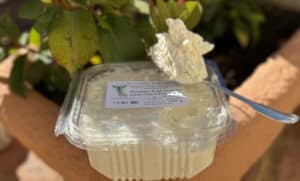
Preparing Red Kuri Squash
- Rinse and scrub pumpkin thoroughly. Cut off stem and bottom to stabilize the squash (easier with a serrated knife).
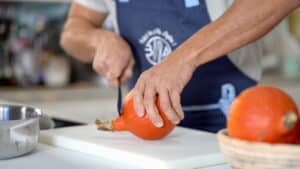
- Cut squashes in half.

- Reach inside with your scoop or spoon and start pulling out the seeds and stringy pulp (this is called the "guts" or "brains"). Dump all the guts directly into your sautoir or saucepan. Do likewise with the remaining squashes.

Potimarron Milk
- Cover the pumpkin guts with milk, add star anises, orange zest and a pinch of salt. Bring to a boil, and cook 25 minutes on medium-low. Turn off the heat, cover the pan and leave it to stand for 20 minutes or longer.

- Mix potimarron milk in the high powered blender.
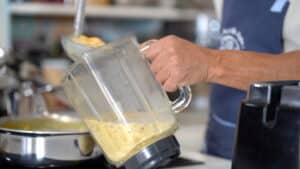
- Pass that goodness through a chinois. Discard solids. Clean the blender for the sauce.
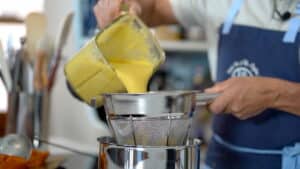
Potimarron Sauce
- Blend all together: potimarron milk, flesh, and heavy cream. Readjust seasoning with salt and pepper. The texture of the sauce shall be thick. Save leftovers sauce to make a pumpkin soup. Simply blend the sauce with the saved and hot chicken stock.
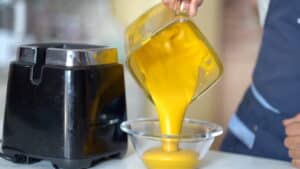
Roasted Potimarron
- Preheat fan oven to 345ºF/175ºC. Season the pumpkin flesh with grey salt, and arrange them skin side up onto a lightly greased baking tray.
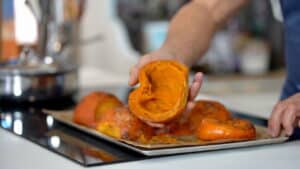
Potimarron Filling
- Cut the roasted potimarron into chunks. In the food processor, pulse the flesh and skin along with the cheese. Season with salt pepper to taste, and add maple syrup to taste. Spread pumpkin mixture straight onto a clean baking tray.

- Roast potimarron filling 35 minutes at 330ºF/160ºC. This extra cooking step allows the filling to firm up and intensifies flavors. To cool off faster, crisscross with a spatula and spread over the cooked chestnuts; set aside.
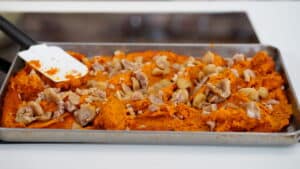
Chestnuts
- Cook the peeled chestnuts in chicken stock for 30 minutes until fork tender. Drain and save chicken stock to make a pumpkin soup.
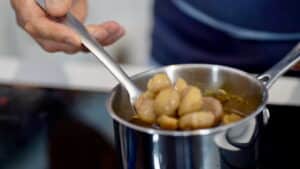
To Assemble the Potimarron Strudel (3 logs)
- On a clean work surface, place your first sheet of filo dough. Using a pastry brush, generously coat the entire surface with melted butter. Carefully lay a second sheet of filo directly on top. Brush this second sheet thoroughly with butter. Top with the third and final sheet, and once again, brush the entire surface with butter.
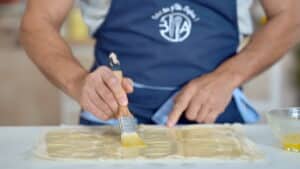
- Pipe a thick rope of potimarron filling (about 500g) per log.

- Roll into a tight and squared log.
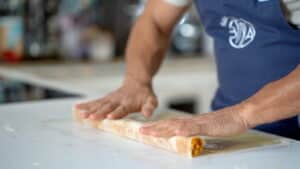
- Brush the whole log with butter. Repeat twice.

- With a serrated knife, cut each log into four 125g mini bûche servings.
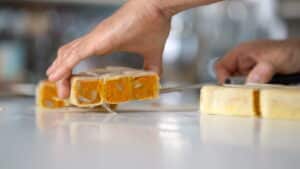
Storage
- Potimarron strudels can be store in the refrigerator for up to 3 days.
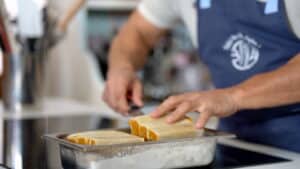
- For longer shelf life: Freeze strudels first and vacuum-seal. A day prior to serve, remove strudels from the bag and let them thaw onto a baking sheet overnight in the refrigerator.

Cleaning and Cutting Leeks
- Leave the stringy root intact to hold the layers together. Slice off the dark green leaves, leaving only the pale green and white parts. (Save the dark green tops for stock). Cut the leeks in half lengthwise twice from the root.

- Slice crosswise into thin half-moons.
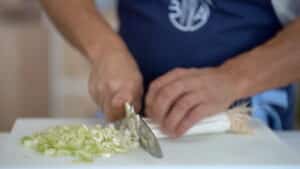
- Place the sliced leeks in a large bowl of lukewarm water. Swirl them around with your hands to loosen any grit. Let them sit for 10 minutes. The sand and dirt will sink to the bottom. Gently lift the leeks out of the water with your hands or a slotted spoon, leaving the grit behind. Repeat this process until no more grit remains. Drain well.
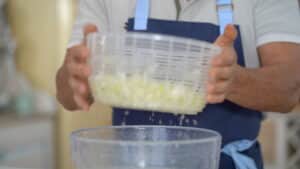
Braised Leeks
- In a skillet or sautoir melt the duck fat over low heat. Add the drained leeks and toss to coat in the fat. Cover the pan and let the leeks cook gently for about 10 minutes. They will steam in their own moisture, which helps them become tender without browning. Remove the lid, and season with salt and pepper to taste. Increase the heat slightly and continue to cook, uncovered, stirring occasionally for 10 more minutes. Remove from the heat and stir in parmesan.
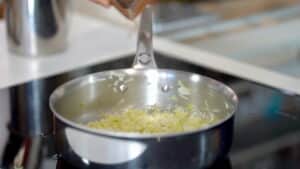
Plating
- Preheat fan oven to 330ºF/160ºC. In a frying pan, sear strudels (one per serving) in some clarified butter or duck fat 2 minutes on each side, and finish them in the oven for 10 minutes. Cut strudel into 3 towers for one serving.

- Put the sauce on the plate first.
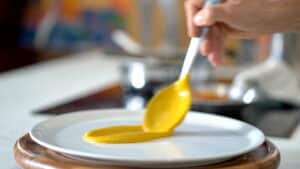
- Add some braised leeks, and top with hot strudel towers. Garnish with a couple of reheated chestnuts.

- Sprinkle some crushed hazelnut over the dish. Bon appétit!
